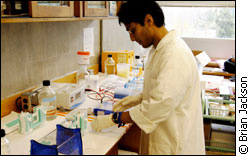|
Scientist wins award
for plant research
By Brian Jackson
OTTAWA —
Susan Aitken's found a way
to turn corn into a toxic-sucking vacuum.
 |
| Faraz Quazi, an undergraduate
student in Susan Aitken's lab, helps with her sulfur
amino acid research. Aitken has seven students in
her lab. |
The Carleton University professor of Biology and Biochemistry
won a $10,000 Petro-Canada Young Innovator Award for
her research in phytoremediation — a process where
by plants can soak up heavy metals.
The cash will be put towards her research in that area,
but it is just one of the applications where Aitken’s
science has potential. In addition to cleaning up contaminated
sites, Aitken is looking into methods of growing more
nutritious legume crops. She is also researching treatment
for heart disease.
Aitken has discovered this array of applications by
studying sulfur amino acid regulation. Sulfur molecules
are created by enzymes in every living thing, from microorganisms,
to plants, to humans.
In plants, amino acids carrying more sulfur molecules
boost protein levels to protect from toxicity. However,
in humans, high levels have been linked to heart disease.
Aitken applied for this award focusing on her environmental
clean-up efforts because she figured Petro-Canada would
be interested.
"They’re a refining company, so they care
about the image they’re portraying," Aitken
says. "They might be more interested in funding
a project that helps to clean the environment."
The plants that clean
The process of cleaning contaminated sites using plants
is called phytoremediation. Some plants have the natural
ability to soak up toxins from the soil, so they can
be planted, left to grow, then uprooted and destroyed
– presto, the site is clean. But relying on nature
to supply these fickle plants won’t cut it, says
Aitken.
"Some plants are specifically adapted to different
sites, so some plants will take up cadmium but not copper,
some take up zinc but not nickel," she says.
Plants that do soak up metals well tend not to grow
very large or very fast – they’re no pumpkins.
"Corn grows quite large, quickly over the summer,
so it could take up a lot of metals from the ground,
then we can harvest it and incinerate it," Aitken
says.
| "Corn grows
quite large, quickly over the summer, so it could
take up a lot of metals from the ground, then we
can harvest it and incinerate it." |
Though she is speaking hypothetically, an agricultural
crop wouldn’t be used because of the risk of having
it accidentally harvested for human consumption.
Instead, Aitken wants to give nonagricultural plants
the ability to act like a toxic sponge.
"We want to understand how plants are able to
do it," Aitken says. "Then we can transfer
that ability to other plants."
Research continues to grow
Aitken’s just beginning to figure out how this
might be done. Whether through traditional plant breeding
or even genetic engineering, transferring the toxic
vacuum ability is a long-term goal.
With the award money, Aitken plans to buy a machine
that will process plant samples taken from the Carleton
greenhouses in the Nesbitt Biology Building.
"When we take a plant sample, we have to grind
them into different buffers to see how much metal they’ve
absorbed," Aitken explains. The machine will make
things "much less manual and laborious."
After the molecules of a plant are neatly sorted by
the machine, they can be examined. Aitken even plans
to bring another student on board the project.
After being at Carleton for two years, Aitken is now
moving towards the other research goals she feels are
important. Her environmental conscience motivates the
phytoremediation work.
"Its an environmentally relevant question, there
are a lot of contaminated sites in Canada,” Aitken
says. “It is reaching the point where we really
have to wake up and take notice of this."
|